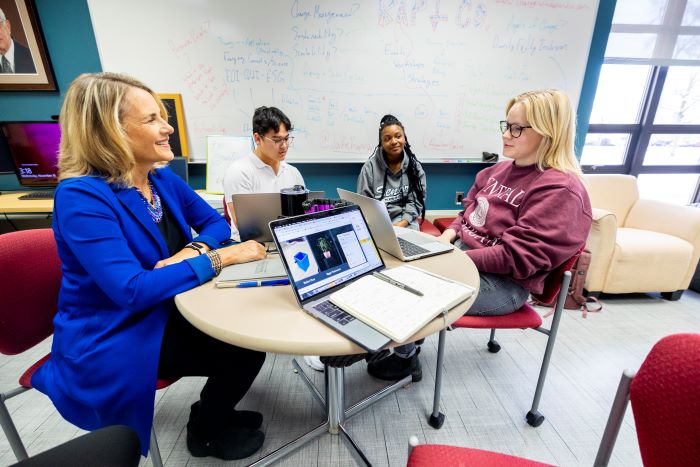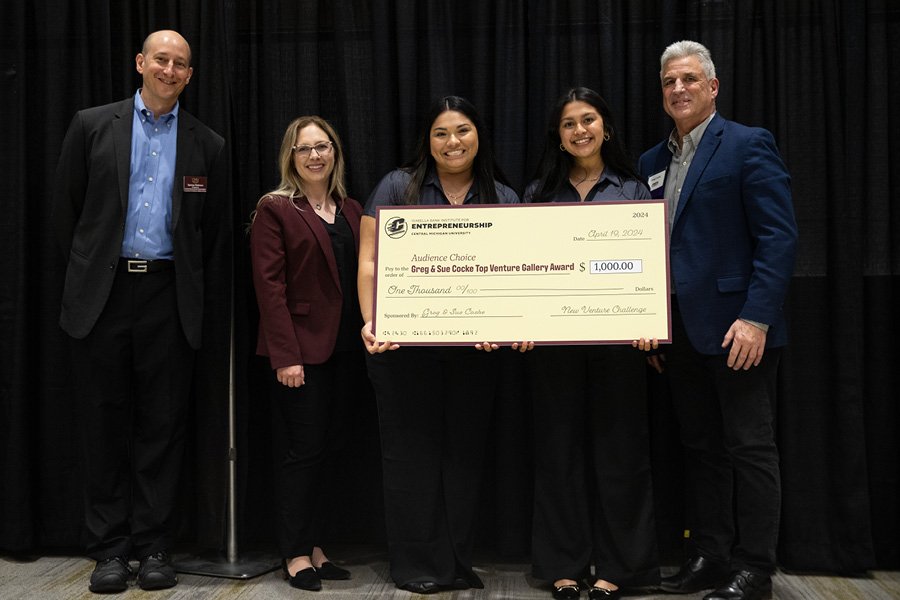
Start up
Passion. Potential. Pitches. Don't miss any of the 2025 New Venture Challenge excitement.
Tune in Friday, April 11 at 1 p.m. for great ideas and fierce competition. Then, join the judges, mentors, spectators and teams as they see who is going home with thousands of dollars in venture financing. The awards broadcast begins at 6:30 p.m. and one team will walk away as the overall best venture.
Central Michigan University’s College of Business Administration is the home of the Isabella Bank Institute for Entrepreneurship and the first Department of Entrepreneurship in the state of Michigan. We are a student-centric hub where experiential, curricular, and external entrepreneurial opportunities intersect.
Our mission is to maximize student success by fostering a campus-wide entrepreneurial mindset that promotes inter-disciplinary collaboration and the creation of new ventures.
We aim to create innovative programming, boost cross-campus and ecosystem collaboration and provide a comprehensive mentoring program.
Our institute provides extracurricular opportunities and is open to all undergraduate and graduate CMU students.
Are you interested in becoming an entrepreneur?
Every journey is unique. Explore the opportunities that interest you.
Humans have spent thousands of years figuring out how — or whether — to live side by side with wolves.
And then, in the early 2000s, Central Michigan University biology faculty member Tom Gehring conducted some of the first rigorous scientific research into nonlethal ways to manage wolf populations near farms that raise livestock.
"We did the work because no one had done it before," Gehring said. "I was tired of hearing that nonlethal methods don't work, without any evidence. So I thought, well, let's go find the evidence and see what it tells us."
With a team of CMU graduate and undergraduate students, that's exactly what Gehring did. Now he finds their research and expertise have new relevance. Federal protection for wolves ended in 2020 across most of the U.S., leaving control and management up to states. Talk of wolf hunting is stirring passions in Michigan and elsewhere, including Wisconsin and Idaho.
Gehring, a hunter himself, says killing wolves may not be the best answer. Hunts throw wolf packs into disarray that can lead to more attacks on livestock and make space for new predators to move in. And although it's costly to a farmer when wolves kill livestock, he notes that it is a small problem: In 2019, only six of 900 Michigan livestock farms reported losses by wolves.
From about 2003-11, Gehring and his team explored three ways to keep wolves from killing livestock. Here is what they learned:
Their projects earned international respect. In a 2016 review, the scientific journal Frontiers in Ecology and the Environment said two of Gehring's studies met the "gold standard" for scientific rigor, the only studies to receive that designation out of a dozen studies it considered worldwide.
"We've had an intimate relationship with wolves for probably our whole history as a species," Gehring said. "Our dogs come from wolves. We have a whole mythology with wolves: stories, legends, fairy tales. People are fascinated with this predator that lives in a family group."
Fascinated — but also fearful. For decades, Michigan and other states paid hunters bounties to kill wolves.
"The goal was to exterminate all wolves," Gehring said. Packs vanished from the U.S. except in Alaska and a sliver of Minnesota.
A focus on ecology shifted attitudes beginning in the 1970s, and by 1991 Michigan once again had a small but growing native wolf population.
Now, Gehring wonders if the tide is turning again.
"My concern is that we will overcompensate and let emotions drive us down a road of reducing populations," he said. "I don't think anyone's going to win in that situation. We would waste a lot of money if we reduce wolf populations too severely and make them threatened again."
So Gehring wants to do what he can to shed light on the science of nonlethal management. Several months ago, he spoke about wolf issues with an aide to state Sen. Dayna Polehanki in southeast Michigan. German officials also have reached out to Gehring to join an international workshop as one of six global experts to assist them with managing wolf populations.
His aim is to safeguard both livestock on farms and wolves in the wild.
"If we can reduce the problem, farmers have less economic loss, and that's important to me since I come from a farming background," he said. "You also coexist with these wolves. They remain in an area; we control or manage the situation effectively in the long term.
"That's a win-win."

Explore special opportunities to learn new skills and travel the world.

Present your venture and win BIG at the New Venture Challenge.

Boost your entrepreneurial skills through our workshops, mentor meetups and pitch competitions.

Learn about the entrepreneurship makerspace on campus in Grawn Hall.

Present a 2-minute pitch at the Make-A-Pitch Competition and you could win prizes and bragging rights!

Connect with mentors and faculty who are here to support the next generation of CMU entrepreneurs.

Are you a CMU alum looking to support CMU student entrepreneurs? Learn how you can support or donate to the Entrepreneurship Institute.